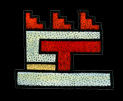Aztec and Maya Calendar
In the tonalpohualli, the sacred Aztec calendar, Tuesday April 28, 1981 is:
Xihuitl:
solar year


8 - Calli (house)
Xiuhpohualli:
365-day calendar
17 - Tlaxochimaco (IX)
Long Count:
Mayan calendar
12.18.7.16.0
(Correlation: Alfonso Caso - Nicholson's veintena alignment [adjust])
The significance of this day
Day Xochitl (Flower, known as Ahau in Maya) is governed by Xochiquetzal, Flower Feather, as its provider of tonalli (Shadow Soul) life energy. Xochitl is a day for creating beauty and truth, especially that which speaks to the heart who knows it will one day cease to beat. Xochitl reminds us that life, like the flower, is beautiful but quickly fades. It is a good day for reflection, companionship and poignancy; it is a bad day for repressing deep-seated wishes, desires and passions.
The thirteen day period (trecena) that starts with day 1-Xochitl (Flower) is ruled by Huehuecoyotl, Old Coyote, the Trickster, god of deception. This trecena signifies the sacred role of the jester: revealing the truth of the old ways by treating them as irreverantly as the gods do, the jester treats nothing as sacred and so points out the sacredness of everything. These are 13 days profoundly influenced by creativity and playfulness: music, dance, art and poetry are simply masks worn by the jester to tear away the away the masks of civilization. The trickster-jester-clown is the final mask of human beings: at one with the divine absurdity of the world, the mortal creator moves toward becoming an immortal force of nature. These are good days to make things; bad days to fear what others might think.
Jessica Alba was born on day 1-Xochitl.
Aztec facts
The last day of the current xiuhmolpilli (bundle of 52 years) will be September 27, 2026.

